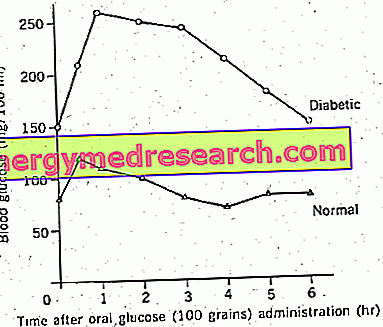See also: Insulinemic curve
Generality
The glycemic curve is a clinical test carried out to evaluate the metabolism of carbohydrates and identify their alterations.
Also called OGTT (from the English " Oral Glucose Tolerance Test "), the glycemic curve measures the concentration of sugars in the blood, before and after oral administration of a certain amount of sugar solution.

The glycemic curve is useful for the diagnosis of diabetes mellitus and is usually performed when fasting blood glucose is repeatedly found to be between 110 and 126 mg / dl.
- In healthy people, the body produces a certain amount of insulin when glucose circulates in the blood.
- Insulin prevents glucose from exceeding the maximum level tolerated by the body, beyond which the excess dose is stored in the liver.
- Exceeding this threshold level indicates reduced glucose tolerance (IGT or " Impaired Glucose Tolerance "), thus an initial relative insulin deficiency that could develop into diabetes .
What's this
The glycemic curve is an exam that measures blood glucose values with a sample taken at fasting and two hours after taking an oral glucose solution .
The glycemic curve test is also used in pregnancy for the screening of gestational diabetes, a condition that is important to keep under control for the health of the mother and the unborn child.
To remember
Diabetes is a chronic disease characterized by an increase in the concentration of glucose in the blood due to a deficiency in the production or function of insulin.
Why do you measure
The glycemic curve is a test that is performed to understand if the concentration of glucose in the blood is within the normal range. Therefore, the examination is useful for screening and diagnosis of diabetes and prediabetes, as well as allowing the monitoring of patients who have high (hyperglycaemia) or low concentrations (hypoglycemia) of blood glucose.
The tolerance test on oral glucose is often performed in pregnant women, to detect the possible presence of gestational diabetes.
Usefulness in the diagnosis of diabetes
The oral glucose load tolerance test (OGTT - Oral Glucose Tolerance Test) is used to diagnose diabetes mellitus in the presence of doubtful fasting glucose values.
We recall, in this regard, that the ADA (American Diabetes Association) has established the value of 126 mg / dl as the threshold beyond which (on an empty stomach) diabetes is defined; when the glycemic values are between 100 (American Diabetes Association) - 110 (World Health Organization) and 126 mg / dl one speaks instead of impaired fasting blood glucose.
When is the exam prescribed?
The glycemic curve is an examination indicated by the treating physician if there is a well-founded suspicion of an alteration of carbohydrate metabolism.
The test should be performed, generally, in the morning and strictly on an empty stomach, with a further measurement that will serve as a contrast and comparison. This latter determination typically occurs two hours after ingestion of a controlled glucose load.
Normal values
For the realization of the glycemic curve, fasting values are identified and two hours after the ingestion of glucose.
- In fasting venous plasma, normal lower blood glucose levels are considered
- at 110 mg / dl in the fasting state
- at 140 mg / dl as regards the value measured two hours after ingestion of controlled amounts of glucose.
- For gestational diabetes, however, the parameters are different. Values are considered normal:
- up to 95 mg / dl immediately after taking the glucose solution;
- up to 180 mg / dl after 60 minutes;
- less than 155 mg / dl after 120 minutes.
Altered Glycemic Curve - Causes
- If the glucose curve test shows post-ingestion glucose values between 140 and 200 mg / dl and fasting levels are between 110 and 126 mg / dl, the alteration is identified as “reduced glucose tolerance ” . This medical condition is of fundamental importance, since, although not yet evolved in diabetes mellitus, it still presents problematic characters that must be appropriately addressed. Patients are, in fact, exposed to greater risks with regard to cardiovascular diseases (specifically with regard to ischemic heart disease). Most often, impaired glucose tolerance is associated with the presence of metabolic syndrome (ie the presence of a state of insulin resistance), compensatory hyperinsulinemia, reduced levels of HDL cholesterolemia or arterial hypertension.
- Diabetes mellitus is defined when the fasting values exceed 126 mg / dl and 200 mg / dl as regards those two hours after ingestion of glucose or sugar. Among the risk factors, which typically raise the possibility of contracting this disease, we find: high concentration of triglycerides, hypertension, obesity and a sedentary lifestyle.
Frequently, elevated glucose levels are indexes of diabetes, but many other diseases and problems can cause changes in the glycemic curve, such as:
- Acromegaly (endocrine-metabolic pathology determined by an excessive production by the pituitary of the growth hormone, GH);
- Chronic kidney disease;
- Cushing syndrome;
- Hyperthyroidism;
- hyperadrenocorticism;
- Pancreatic tumor;
- Pancreatitis.
The glycemic curve can also be altered by some factors, such as:
- Malabsorption syndrome;
- Acute stress (response to trauma, heart attack and stroke);
- Excessive food intake.
How to measure it
As anticipated, a very useful test to define the diagnosis of diabetes in the presence of equivocal data is the so-called oral glucose loading test. This test is based on the administration by mouth of a fixed quantity of glucose in aqueous solution, followed by some small blood samples at pre-established time intervals. These samples are necessary for the determination of the glycemic curve (trend of glucose concentration in the blood) and possibly for the dosage of other blood parameters (insulin and other hormones, such as hGH, whose secretion is influenced by glycemic levels).
The tolerance test to oral glucose load must be performed according to certain criteria:
- Administration of 75 grams of glucose in 250-300 mL of water, within a period of time ranging from 30 seconds to 5 minutes (in the child, or in the patient weighing less than 43 kg, the glucose dose will be 1, 75 g per kg of weight);
- Blood samples before and two hours after intake, or before and after 30 ', 60', 90 'and 120'.
Preparation
In the three days preceding the exam, the patient must take at least 150 grams of carbohydrates per day and stop taking drugs that can intervene with carbohydrate metabolism.
At the time of the examination, which is generally performed in the morning, the patient must be fasting for 8-14 hours (water is allowed, but not alcohol or sugary drinks); we do not proceed if the fasting glucose value is higher than 126 mg / dl.
Since more measurements are needed over time, it is important to remain fasting, without smoking until the next samples are taken, trying to avoid getting agitated.
Interpretation of Results
Interference, normal values and interpretation of results
The presence of diseases such as hyperthyroidism, hyper-corticosurenalism, acromegaly, malabsorption syndrome and gastroenteropathias can interfere with the test results. Even pregnancy can alter the glycemic curve, so much so that the same examination, with similar protocols, is used for the evaluation of gestational diabetes.
The interpretative criteria of the glycemic curve are shown in the following table:
| Glycemic levels | Normal | Altered blood sugar a fasting (IFG) | Altered tolerance glucose (IGT) | Diabetes mellitus (DM) | ||||
|---|---|---|---|---|---|---|---|---|
| Venous plasma | Fasting | 120 ' | Fasting | 120 ' | Fasting | 120 ' | Fasting | 120 ' |
| (Mg / dl) | <110 | <140 | > 110 - <126 | <140 | <126 | > 140 <200 | > 126 | > 200 |
| (Mmol / l) | <6.1 | <7.8 | > 6.1 - <7.0 | <7.8 | <7.0 | > 7.8 | > 7.0 | > 11.1 |
1999 WHO Diabetes criteria - Interpretation of Oral Glucose Tolerance Test
NOTE:
- the detection of glycaemia above 200 mg / dL after two hours of glucose loading indicates (if confirmed a second time) the presence of diabetes mellitus even if the fasting glucose is lower than 126 mg / dL.
- The impaired glucose tolerance is a condition to be monitored constantly, both for the possible evolution to diabetes mellitus, and for the greater cardiovascular risk compared to normoglycemic people. A similar discourse in the presence of impaired fasting blood glucose, a condition that is less worrying than the previous one.



